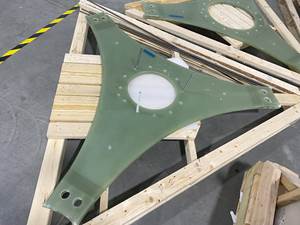CompoSIDE delivers cost and time saving for composites consultancy
STRUCTeam cites £40,000 savings in licensing costs and up to 40% reduction in design time by using this web-based composites design engineering solution.
By using the web-based composites design engineering solution CompoSIDE (Cowes, Isle of Wight, UK), composites consultancy STRUCTeam (Cowes, Isle of Wight, UK) has saved over £40,000 in software licensing costs in 2014 while reducing composite application design time between 25% and 40%.
“Our design teams have been using CompoSIDE for over three years during its development on a wide range of client projects with successful outcomes,” explains STRUCTeam’s Engineering Manager Chris Monk. “We have made substantial cost savings by choosing CompoSIDE composites design software, and the unique functionality of the web-based solution enables us to test composites solutions collaboratively at an early stage. This saves our clients further time and money, improves the final solution and gives us a competitive advantage.”
According to Monk, one of the biggest challenges STRUCTeam faces is to quickly establish and develop concepts that will work: “Deriving very complex finite element analysis (FEA) solutions in the early stages of a composites application’s development is not cost effective. Yet hand calculations can be overly simplistic. CompoSIDE bridges the gap . . . enabling our engineers to design from the outset to the right level for the maturity of the project and product we are developing.”
STRUCTeam recently applied CompoSIDE to development of a novel composites driveshaft for offshore wind turbines. By completing most of the composite component development work using the laminate design, beam section and FEA tools, a more innovative design was achieved at much reduced costs. Monk explains, “These tools and the integrated nature of the web-based solution enabled us to cycle through multiple design options in a very short space of time. When the laminate and overall concepts were proven by using the CompoSIDE toolsets, the information was exported to an FEA package using FELink so that detailed design work and the final verification could be completed efficiently.”
STRUCTeam has also applied CompoSIDE in the marine sector. “Many of the detailed structures within a high performance race boat can be simplified into representative beams and panels structures,” says Monk. “We can manage the entire composites development of these structures within CompoSIDE. We use the software’s materials database to control the project input data, the laminate design module (LAMINASpace) to derive baseline layup configurations and then we use the SECTIONSpace module to build appropriate representations of key structural areas. The fast turnaround on these activities enables our engineers to remain one step ahead of the very aggressive build schedules for these types of projects. Overall, using CompoSIDE allows us to focus on solving the real design challenges we are facing rather than on how to model a complex problem using spreadsheets developed in-house.”
Monk also notes that CompoSIDE’s subscription model that charges according to usage has directly saved on software licensing costs: “CompoSIDE’s licensing model is not based on the classic site or user license approach. Instead we pay for the calculation tools needed for each specific project and only when we use them.” He notes that a large range of functionality is included in the basic subscription. “That means we don’t have to invest in multiple mainstream FE software licences that we would not be using at full capability.” This contributes to how STRUCTeam saved an estimated £40,000 in 2014.
CompoSIDE is exhibiting at JEC 2015 (March 10-12, Paris, France) within the Composites UK booth in Hall 7.2, Stand Number C67.
Related Content
Trends fueling the composites recycling movement
Various recycling methods are being considered for composites, from novel dismantling and processing, to building capacity and demonstrating secondary use applications.
Read MoreHonda begins production of 2025 CR-V e:FCEV with Type 4 hydrogen tanks in U.S.
Model includes new technologies produced at Performance Manufacturing Center (PMC) in Marysville, Ohio, which is part of Honda hydrogen business strategy that includes Class 8 trucks.
Read MoreComposites end markets: Energy (2024)
Composites are used widely in oil/gas, wind and other renewable energy applications. Despite market challenges, growth potential and innovation for composites continue.
Read MoreRTM, dry braided fabric enable faster, cost-effective manufacture for hydrokinetic turbine components
Switching from prepreg to RTM led to significant time and cost savings for the manufacture of fiberglass struts and complex carbon fiber composite foils that power ORPC’s RivGen systems.
Read MoreRead Next
Ceramic matrix composites: Faster, cheaper, higher temperature
New players proliferate, increasing CMC materials and manufacturing capacity, novel processes and automation to meet demand for higher part volumes and performance.
Read MoreNext-gen fan blades: Hybrid twin RTM, printed sensors, laser shock disassembly
MORPHO project demonstrates blade with 20% faster RTM cure cycle, uses AI-based monitoring for improved maintenance/life cycle management and proves laser shock disassembly for recycling.
Read MoreUltrasonic welding for in-space manufacturing of CFRTP
Agile Ultrasonics and NASA trial robotic-compatible carbon fiber-reinforced thermoplastic ultrasonic welding technology for space structures.
Read More











